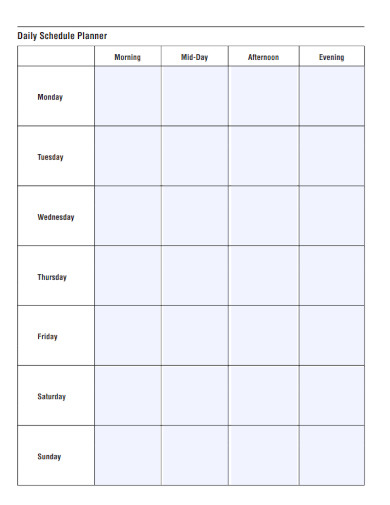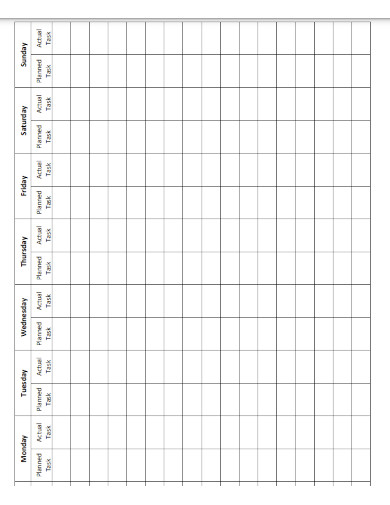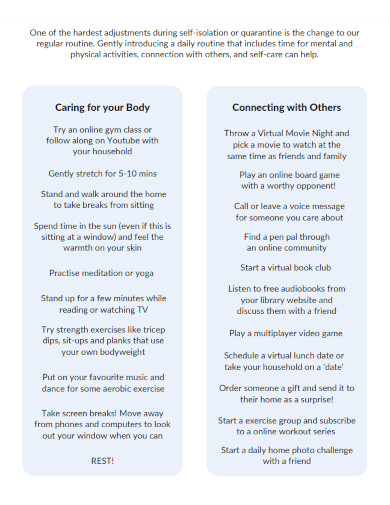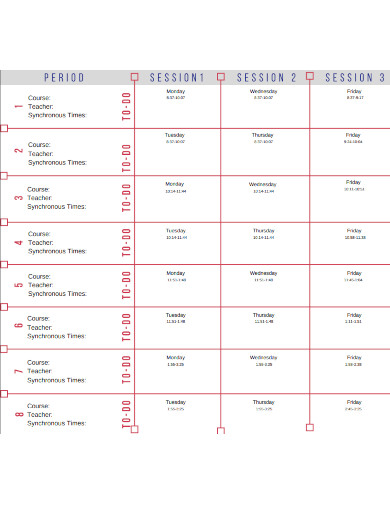4+ Daily Schedule Planner Samples
Even for the most bright and ambitious individuals, time management is one of the most difficult difficulties. It is true that productivity levels fluctuate from day to day, and modern gadgets designed to help us work better and quicker might really work against us. Is there anything on your agenda that you consider urgent? It’s a frequent sensation that occurs when you fail to prioritize tasks according to their value. It may be tough to handle all of the duties of the day at times, and if your priority jobs aren’t at the top of the list, your performance and productivity will suffer. This is why keeping a daily agenda planner handy is essential. Need some help with creating this? We’ve got you covered! In this article, we provide you with free and ready-made samples of Daily Schedule Planners in PDF and DOC format that you could use for your benefit. Keep on reading to find out more!
1. Daily Schedule Planner Example
2. Daily Task Schedule Planner Template
3. Daily Home Schedule Planner
4. Daily Activity Schedule Planner
5. Student Daily Schedule Planner
What Is a Daily Schedule Planner?
Project management relies heavily on resource planning and scheduling. It enables you to anticipate the project’s scope and manage/assign your resources accordingly. Furthermore, it offers an overview of who is accountable for what and when. A schedule planner, on the other hand, is an academic advising tool that allows students to create a customised timetable for the following term. It will be beneficial to students when designing their ideal timetable.
How to Make a Daily Schedule Planner
Keeping your work and family life in balance may be as simple as actively arranging your calendar to incorporate key chores. A Daily Schedule Planner Template can help provide you with the framework you need to ensure that you have a well-prepared and robust planner on hand. To do so, you can choose one of our excellent templates listed above. If you want to write it yourself, follow these steps below to guide you:
1. Take notes on everything.
Start by writing out every personal and professional duty you wish to do in a typical week. Instead of editing or arranging, concentrate on brainstorming. Include jobs that you undertake on a regular basis, such as changing the sheets on the bed or mowing the yard, as well as daily duties like preparing breakfast or cleaning the dishes.
2. Determine your priorities.
After you’ve created your master list, look through it and choose your daily priorities. Use a highlighter to visually categorize your priorities into four categories: work, personal, wants, and necessities. For example, in blue, emphasize daily business demands such as responding to emails or returning phone calls, while in green, highlight personal desires such as reading a book for enjoyment or going out for coffee with a friend. Do this for your whole to-do list.
3. Organize comparable jobs together.
Determine whether you can group or streamline comparable activities. For example, if “wash the dishes” and “wipe down surfaces” are on your daily to-do list, consider doing them simultaneously or one after the other because they both require similar supplies and take place in the same room.
4. Streamline your tasks.
Examine your weekly plan to see if any areas or tasks may be simplified or optimized to save time. Consider using a grocery delivery service or rescheduling the chore to a weekday instead if you often go to the grocery shop on Sundays but don’t have time to manage other activities that day. Do this on any days that appear to be exceptionally busy.
FAQ
What exactly are scheduling abilities?
Scheduling abilities relate to the capacity to tackle such difficult and stressful situations by arranging your actions so that you may finish all of your tasks and goals according to your priorities while staying within the time constraints.
What’s the difference between a plan and a schedule?
A timetable assigns times and dates to particular phases of the plan, whereas a plan defines how to handle a problem. So the plan comes first, followed by the timetable, which is related to it based on relevance, urgency, or other factors.
What does it mean to plan and schedule a project?
The list of activities, deliverables, and milestones within a project is referred to as scheduling in project management. A timetable generally specifies a start and completion date, as well as the duration and resources allocated to each activity. Successful time management necessitates effective project scheduling.
Scheduling allows you to consider what you want to do in a day, week, or month and keeps you on track to meet your objectives. To help you get started, download our easily customizable and comprehensive samples of Daily Schedule Planners today!
Related Posts
FREE 7+ Fashion Business Plan Samples in PDF
FREE 10+ Sprint Planning Samples In MS Word | Google Docs | PDF
FREE 10+ Wedding Planning Samples in MS Word | Apple Pages | Powerpoint | PDF
FREE 9+ Monthly Study Planner Samples in PSD | Illustrator | InDesign | PDF
FREE 9+ Sample Curriculum Planning Templates in PDF | MS Word
FREE 10+ Teacher Development Plan Samples in MS Word | Google Docs | Apple Pages | PDF
FREE 10+ Basketball Practice Plan Samples in PDF
FREE 12+ School Business Plan Samples in PDF | MS Word | Apple Pages | Google Docs
FREE 7+ Client Strategic Plan Samples in PDF | MS Word
FREE 11+ Trucking Business Plan Templates in PDF | MS Word | Google Docs | Pages
FREE 7+ Small Hotel Business Plan Samples PDF | MS Word | Apple Pages | Google Docs
FREE 14+ Bakery Business Plans in MS Word | PDF | Google Docs | Pages
FREE 4+ Yearly Lesson Plan Samples in PDF
FREE 50+ Strategic Planning Samples in Google Docs | Pages | PDF | MS Word
FREE 10+ Construction Project Plan Samples in MS Word | Google Docs | Apple Pages | PDF





